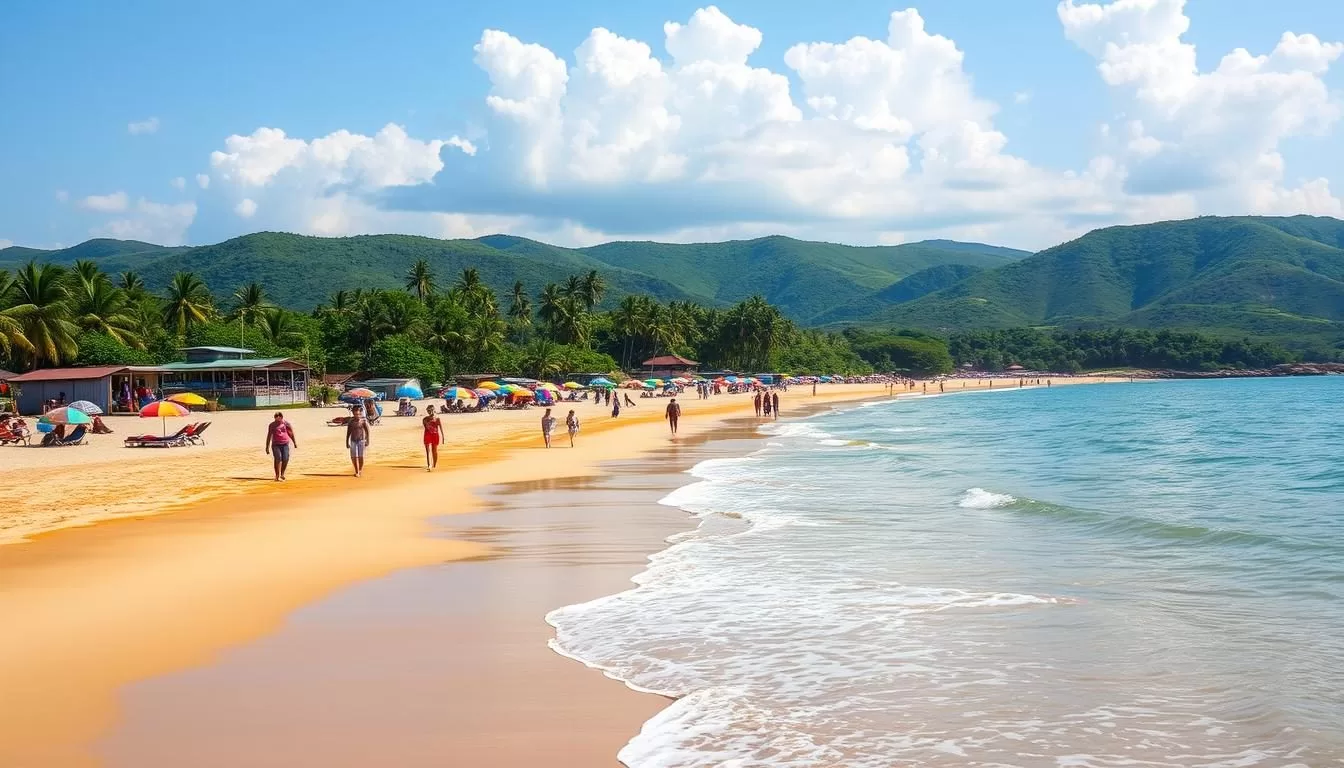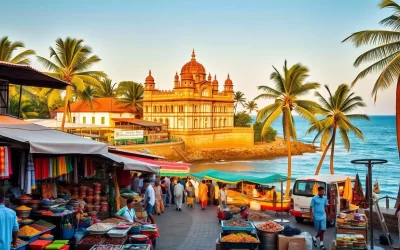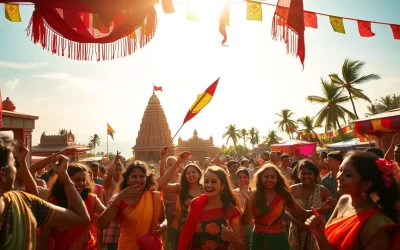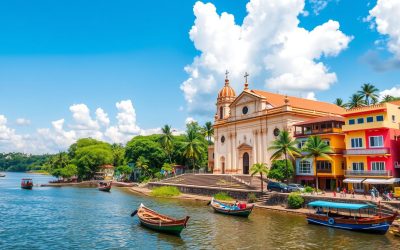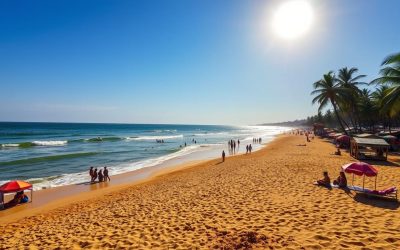✓ Accommodations✓ Flights✓ Rental Cars✓ Tours & Activities
Are you planning a trip to Goa, India’s smallest state, known for its stunning beaches and vibrant culture? Understanding the best time to visit is crucial for a memorable experience.
The state’s tropical climate means that it never gets cold, with daytime temperatures consistently above 86 degrees Fahrenheit throughout the year. Winters are dry and less humid, making them ideal for beach activities.
To make the most of your trip, you’ll want to consider the season and weather conditions. Whether you’re looking for a relaxing getaway or an action-packed adventure, timing your visit right is key.
Understanding Goa’s Tropical Climate
As a tropical region, Goa experiences a relatively consistent warm climate. You can visit Goa at any time of the year, thanks to its tropical climate with year-round warm temperatures.
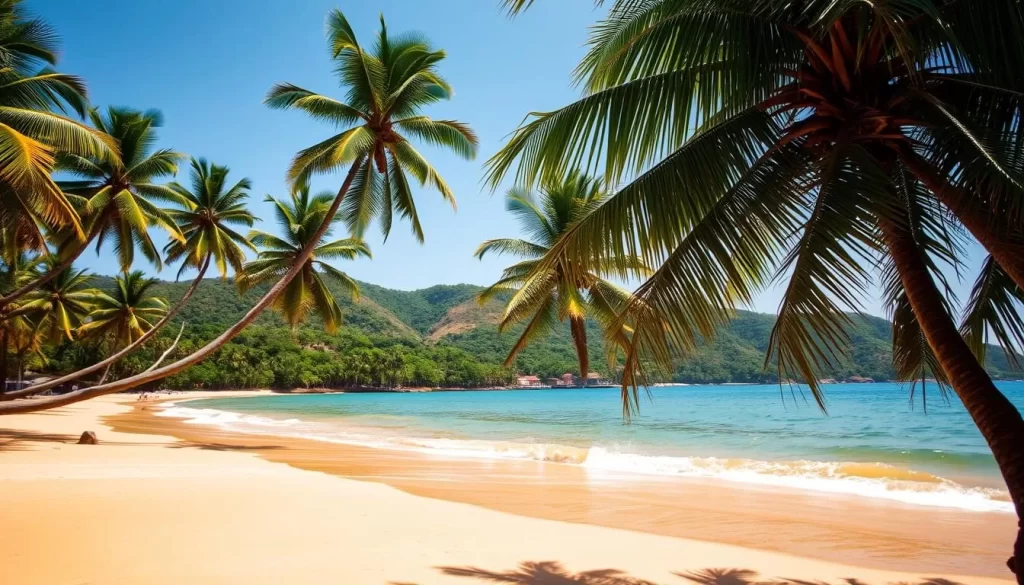
Goa’s Year-Round Temperature Patterns
The temperature patterns in Goa remain relatively consistent, with daytime temperatures rarely dropping below 86°F (30°C) even in winter months. This makes Goa a great destination for you to enjoy warm weather throughout the year.
The Three Distinct Seasons of Goa
You’ll experience three distinct seasons when visiting Goa: winter (November-February), summer (March-May), and monsoon (June-September). Each season offers a unique experience, from the dry and pleasant winter weather to the lush green landscapes of the monsoon season.
Winter brings dry, pleasant weather with minimal humidity and temperatures around 74°F (23°C) at night, creating perfect conditions for beach activities. In contrast, summer sees temperatures rise to around 91°F (33°C) with increasing humidity levels, making outdoor activities challenging during the daytime.
- Winter: dry and pleasant weather, ideal for beach activities
- Summer: rising temperatures and humidity, challenging for outdoor activities
- Monsoon: heavy rainfall, particularly in June and July, creating lush green landscapes
Understanding these seasonal patterns will help you plan your visit to Goa according to your weather preferences and planned activities.
Winter in Goa: Peak Season Paradise (November-February)
From November to February, Goa is at its best, providing an ideal setting for various activities and celebrations. You can experience the state’s vibrant culture, enjoy perfect weather conditions, and participate in numerous events.
Weather Conditions During Winter Months
During winter, Goa enjoys clear skies, low humidity, and comfortable temperatures, making it an ideal destination. Daytime temperatures are around 86°F (30°C), while evenings are cooler at about 74°F (23°C).
Popular Winter Activities and Experiences
Winter is the perfect time to enjoy Goa’s famous beaches, with ideal conditions for swimming, sunbathing, and water sports. You can also participate in activities like parasailing, jet skiing, and dolphin spotting tours that operate at full capacity.
Winter Festivals and Celebrations
Goa hosts several significant festivals during winter, including the International Jazz Festival, Christmas celebrations, and the Feast of Francis Xavier on December 3rd. These events showcase the state’s vibrant atmosphere and cultural heritage.
Visiting in early November or February can help you avoid peak holiday crowds while still enjoying excellent weather. You’re likely to get better deals on accommodations in February as hotels no longer charge peak season prices.
The Bustling Holiday Season: December to Mid-January
The holiday season in Goa is a unique blend of cultural celebrations and vibrant parties. During this time, Goa transforms into a bustling tourist destination, attracting visitors from all over the world.
Christmas and New Year Celebrations
You’ll experience Goa at its most festive during Christmas and New Year celebrations. The region is decorated with elaborate lights, and special events are organized throughout Goa, showcasing its strong Portuguese Catholic influence.
Dealing with Peak Season Crowds
The holiday season brings heavy crowds to popular beaches like Baga, Calangute, and Anjuna. To navigate these crowds, consider visiting lesser-known beaches or exploring the region early in the morning.
Holiday Season Price Considerations
Be prepared for significantly higher prices during this period, with hotel rates often doubling or tripling. Many properties also require minimum stay requirements, adding to the overall cost.
| Aspect | Details | Impact |
|---|---|---|
| Accommodation | Hotels and resorts book up quickly | Prices double or triple |
| Events | Christmas and New Year celebrations | Vibrant atmosphere, special events |
| Crowds | Heavy crowds on popular beaches | Traffic congestion, busy atmosphere |

To make the most of your visit during the peak holiday season, consider booking your accommodations and transportation well in advance to avoid last-minute hassles.
Shoulder Season: The Sweet Spot (February and October-November)
Goa’s shoulder season, which includes February and October-November, presents a sweet spot for tourists. This period offers a perfect blend of good weather, reasonable prices, and manageable crowd levels, making it an ideal time to visit Goa.
February: Post-Peak Season Benefits
February provides post-peak season benefits with winter’s pleasant weather still in effect but with significantly reduced tourist numbers after the holiday rush has ended. Hotel rates drop by 20-30% compared to December-January prices, allowing you to enjoy amenities and activities without the peak season costs.
October-November: Pre-Peak Season Advantages
October-November represents the pre-peak season as Goa transitions from monsoon to winter. Early October may still see occasional showers, but it offers lush green landscapes and excellent deals on accommodations. By November, most beach shacks and water sports operations are fully functional, without the overwhelming crowds of December.
Events and Activities During Shoulder Months
February hosts several notable events, including the Goa Carnival, the Grape Escapade Wine Festival, and the Goa Food and Cultural Festival. These events, along with the pleasant weather, make February an attractive time to visit. In October and November, the atmosphere is serene, and you can enjoy popular beaches like Anjuna, Baga, and Palolem with ample space to relax.
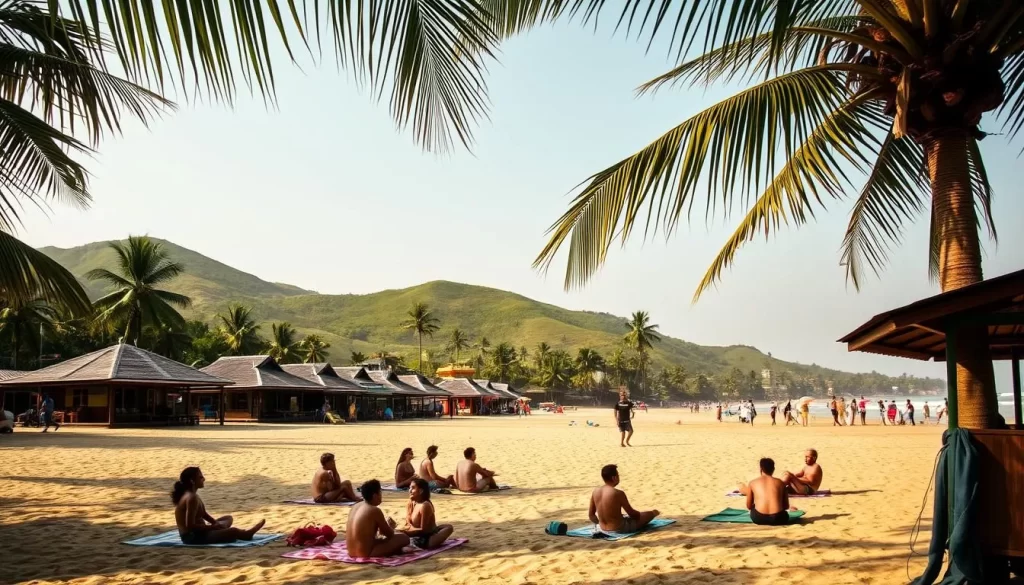
Summer in Goa: March to May
Visiting Goa during the summer season can be a great way to experience the region’s culture and natural beauty. The summer months, from March to May, bring increasing heat and humidity, with daytime temperatures often reaching 91°F (33°C).
Weather Patterns and Heat Considerations
The summer season in Goa is characterized by rising temperatures and humidity. By May, the minimum temperature reaches 82°F (28°C), and humidity levels exceed 70%. Be prepared for the heat and potential isolated thunderstorms towards the end of May.
Summer Activities and Attractions
Despite the heat, summer is an excellent time to explore Goa’s indoor attractions, such as spice plantations, museums, and colonial architecture. You can still enjoy beach activities during the early morning and late afternoon/evening hours when temperatures are more manageable.
Summer Discounts and Deals
The summer months see a significant decrease in international tourists, resulting in substantially lower accommodation rates – often 40-60% less than peak season prices. You can find excellent deals on luxury accommodations, making it possible to stay at high-end resorts and hotels at a fraction of the peak season costs.
Monsoon Season in Goa: June to September
As the southwest monsoon sets in, Goa transforms into a lush paradise from June to September. This period is characterized by significant rainfall, leading to a dramatic change in the landscape.
Rainfall Patterns and Weather Expectations
The monsoon season brings heavy rainfall to Goa, particularly in June and July, with a gradual decrease in August and September. The rain can be unpredictable, sometimes continuing for days and other times appearing as brief downpours.
| Month | Rainfall Intensity | Temperature |
|---|---|---|
| June | Heavy | Decreases slightly |
| July | Heavy | Continues to decrease |
| August | Moderate | Relatively stable |
| September | Light | Starts to rise |
Monsoon Activities and Experiences
Despite the rain, monsoon is a great time to explore Goa’s natural beauty. You can visit Dudhsagar Falls at its peak flow, explore the lush spice plantations, and enjoy the rejuvenated wildlife in Goa’s national parks. Many inland restaurants and hotels remain open, offering special monsoon deals.
Monsoon Festivals and Cultural Events
Monsoon in Goa is not just about rain; it’s also a time for unique cultural celebrations. You can experience Sao Joao on June 24th, Sangodd on June 29th, Bonderam festival in August, and Ganesh Chaturthi in September. These festivals offer a deeper insight into local Goan culture and traditions.
Goa, India: Best Months for a Weather-Savvy Trip
The best time to visit Goa depends on what you want to do, whether it’s enjoying the beaches or exploring cultural sites. Goa’s diverse offerings cater to different preferences, making it a versatile destination throughout the year.
Best Time for Beach Activities
For beach activities and water sports, the best months to visit Goa are November through February. During this period, you’ll experience clear skies, calm seas, and perfect swimming conditions, making it ideal for swimming, parasailing, and jet skiing.
Best Time for Cultural Exploration
Cultural exploration is best during the shoulder seasons, February and October-November. Major sites are less crowded but still fully accessible, with pleasant weather conditions. You can visit historical sites, attend cultural festivals, and enjoy the local cuisine without the peak season crowds.
Best Time for Budget Travelers
Budget travelers should consider visiting during the monsoon season (June-September) for the lowest prices. Alternatively, the shoulder seasons offer the best value-to-experience ratio, with comfortable weather and lower prices compared to the peak season.
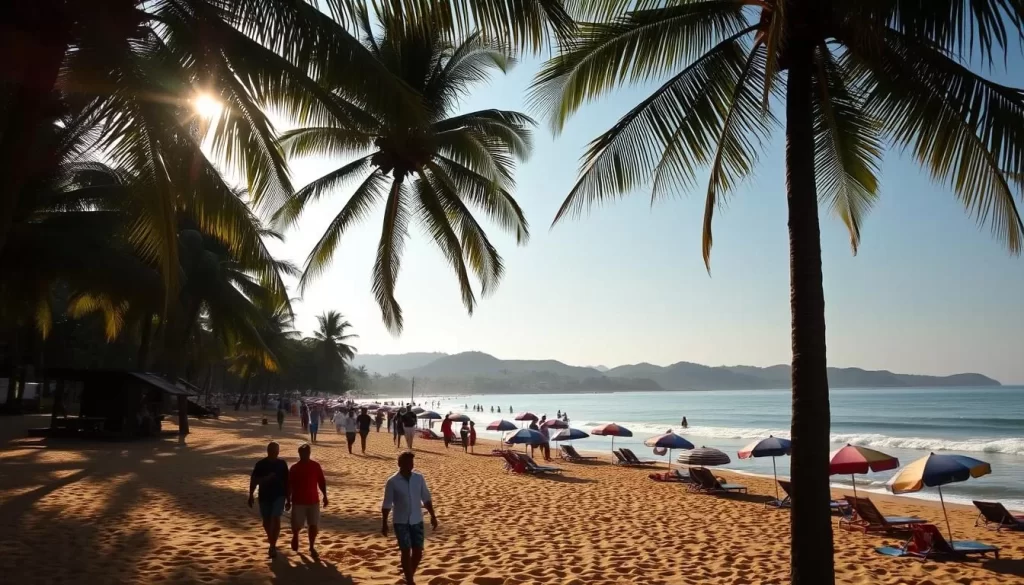
| Traveler Type | Best Time to Visit | Why |
|---|---|---|
| Beach Lovers | Nov-Feb | Clear skies, calm seas, perfect for swimming and water sports |
| Cultural Explorers | Feb, Oct-Nov | Less crowded, pleasant weather, accessible cultural sites |
| Budget Travelers | Jun-Sep or Feb, Oct-Nov | Lowest prices during monsoon, best value during shoulder seasons |
North vs. South Goa: Seasonal Differences
North and South Goa offer unique seasonal experiences that cater to different traveler preferences. Understanding these differences is key to planning a memorable trip.
North Goa Seasonal Highlights
North Goa is known for its vibrant atmosphere, especially during the peak season from December to January. The region’s beaches, such as Baga, Calangute, and Anjuna, become hubs for tourists and party enthusiasts. Beach shacks and nightlife venues operate at full capacity, creating a lively ambiance.
During the monsoon season, North Goa experiences significant rainfall, leading to many establishments closing temporarily. However, this period also offers a unique, serene landscape for those who prefer fewer crowds.
South Goa Seasonal Considerations
South Goa, on the other hand, maintains a more tranquil and peaceful atmosphere throughout the year. The region is ideal for travelers seeking relaxation and luxury. Even during peak season, South Goa’s beaches remain relatively less crowded compared to North Goa.
The monsoon season in South Goa brings lush greenery and rejuvenated landscapes. Although some tourist facilities may close, the region’s better drainage systems handle the rainfall more effectively than North Goa.
Choosing the Right Region for Your Visit
When deciding between North and South Goa, consider your travel preferences. If you’re looking for a vibrant party scene and don’t mind the crowds, North Goa is the place to be during the peak season. For a more relaxed, luxurious experience, South Goa is ideal.
Your choice should also factor in the time of year you plan to visit. If you’re traveling during the shoulder season, South Goa might offer more consistent experiences with less dramatic changes in service availability.
Planning Your Trip: Practical Considerations
As you prepare for your trip to Goa, understanding the practical aspects can make a significant difference in your travel experience. From accommodation and transportation to packing the right gear, being well-prepared is key to a smooth and enjoyable journey.
Accommodation Availability Throughout the Year
Goa offers a wide range of accommodations to suit all budgets. However, the availability and rates vary significantly throughout the year. During peak season (December to January), it’s crucial to book your accommodation well in advance, ideally 3 to 6 months prior, especially if you’re looking for beachfront properties. In contrast, during the monsoon season (June to September), many smaller guesthouses and beach huts close, while larger hotels and resorts remain open but offer significant discounts of up to 50-70%.
Transportation Tips by Season
Transportation in Goa can be quite expensive due to the absence of ride-sharing services like Uber. You can either hire taxis, which charge a flat rate, or rent a car or scooter. The availability of transportation options changes with the seasons. Scooter rentals are widely available during dry months but can be hazardous during monsoon due to flooded roads. Additionally, taxi prices surge by 20-30% during peak season, making it more economical to negotiate rates during off-season months.
| Season | Accommodation | Transportation |
|---|---|---|
| Peak Season (Dec-Jan) | Book in advance; higher rates | Higher taxi prices; limited availability |
| Monsoon Season (Jun-Sep) | Discounts up to 50-70%; limited options | Scooter rentals risky; potential roadblocks |
| Shoulder Season (Feb & Oct-Nov) | Moderate rates; good availability | Reasonable taxi prices; scooter rentals available |
Packing Recommendations for Different Seasons
Packing appropriately for your Goa trip is crucial for a comfortable experience. For winter visits (November to February), pack light cotton clothing, sunscreen, sunglasses, and beachwear, with a light jacket for cooler evenings. During monsoon (June to September), quick-dry clothing, waterproof footwear, umbrellas, rain jackets, and waterproof bags for electronics are must-haves. For summer (March to May), prioritize lightweight, breathable fabrics, high SPF sunscreen, hats, and electrolyte supplements for hydration.
By considering these practical aspects, you can tailor your trip to Goa according to your preferences and budget, ensuring a memorable and enjoyable experience.
Conclusion: Making the Most of Your Goan Adventure
Whether you’re looking for beach activities, cultural experiences, or budget-friendly options, Goa has something to offer throughout the year.
The best time to visit Goa depends on your personal preferences and priorities. Winter months (November-February) provide the most complete Goan experience with perfect beach weather and vibrant nightlife.
For a balance of good weather and reasonable prices, consider the shoulder seasons (February and October-November). Budget travelers might prefer the monsoon months (June-September) for the lowest prices and lush landscapes.
With proper planning, your Goan adventure can be tailored to your interests, whether centered around music festivals, cultural exploration, or relaxing on beautiful beaches.
The above is subject to change.
Check back often to TRAVEL.COM for the latest travel tips and deals.
